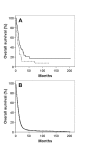Giant cell glioblastoma: a glioblastoma subtype with distinct epidemiology and superior prognosis
- PMID: 19332771
- PMCID: PMC2802403
- DOI: 10.1215/15228517-2008-123
Giant cell glioblastoma: a glioblastoma subtype with distinct epidemiology and superior prognosis
Abstract
Giant cell glioblastoma (GC) is an uncommon subtype of glioblastoma multiforme (GBM). Consequently, the epidemiology, natural history, and factors associated with outcome are not well defined. Patients diagnosed with GC from 1988 through 2004 were identified in the Surveillance, Epidemiology, and End Results (SEER) database. Outcomes were examined with Kaplan-Meier survival analysis and Cox models. For comparison, similar analyses were conducted for patients diagnosed with GBM. GC was identified in 1% of 16,430 patients diagnosed with either GC or GBM. Compared with GBM, GC showed similar gender and racial distributions. Likewise, tumor size and location were not significantly different between the two histologies. GC tended to occur in younger patients with a median age at diagnosis of 51 years, compared with 62 years for GBM. Additionally, patients with GC were more likely to undergo complete resection compared with patients with GBM. For both histologies, young age, tumor size, extent of resection, and the use of adjuvant radiation therapy (RT) were associated with improved survival. Cox modeling suggests the prognosis for GC is significantly superior to that for GBM (hazard ratio = 0.76; 95% confidence interval, 0.59-0.97) even after adjustment for factors affecting survival. GC is an uncommon GBM subtype that tends to occur in younger patients. Prospective data defining optimal treatment for GC are unavailable; however, these retrospective findings suggest that resection, as opposed to biopsy only, and adjuvant RT may improve survival. The prognosis of GC is superior to that of GBM, and long-term survival is possible, suggesting aggressive therapy is warranted.
Figures





References
-
- Ohgaki H, Peraud A, Nakazato Y, Watanabe K, von Deimling A. Giant cell glioblastoma. In: Kleihues P, Cavenee WK, editors. World Health Organization Classification of Tumours: Pathology and Genetics of Tumours of the Nervous System. Lyon, France: IARC Press; 2000. pp. 40–41.
-
- Schmincke A. Beitrag zur lehre der ganglioneurome: ein ganglioneurom des gehirns. Beitr Pathol Anat. 1909/1910;47:354–371.
-
- Meyer O. Ein besonder typus von riesenzellengliom. Frankf Z Pathol. 1913;14:185–203.
-
- Becker DP, Benyo R, Roessmann U. Glial origin of monstrocellular tumor: case report of prolonged survival. J Neurosurg. 1967;26:72–77. - PubMed
-
- Margetts JC, Kalyan-Raman UP. Giant-celled glioblastoma of brain: a clinico-pathological and radiological study of ten cases (including immunohistochemistry and ultrastructure) Cancer. 1989;63:524–531. - PubMed
MeSH terms
LinkOut - more resources
Full Text Sources
Medical
Miscellaneous

